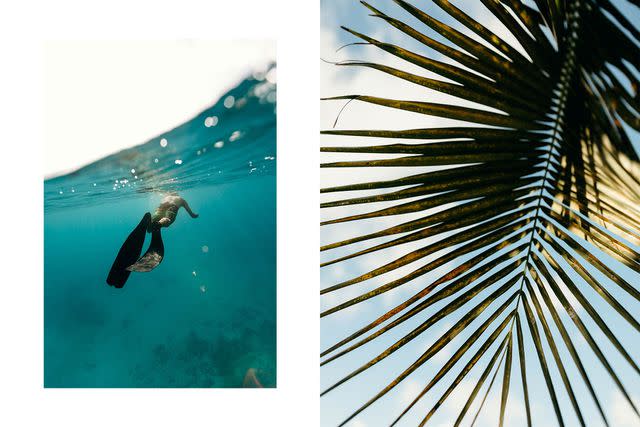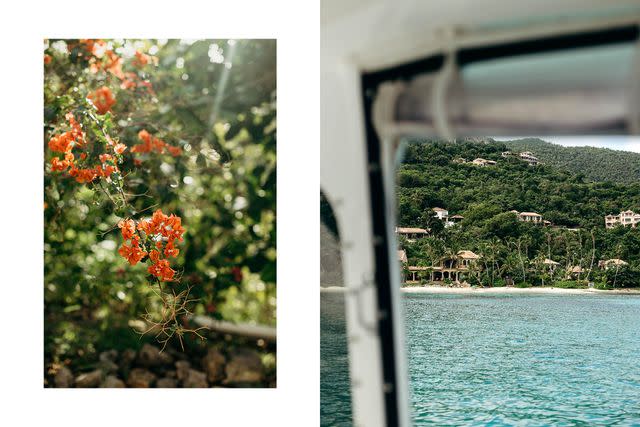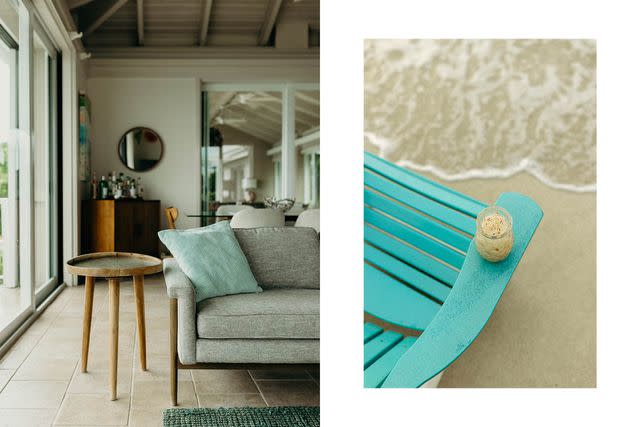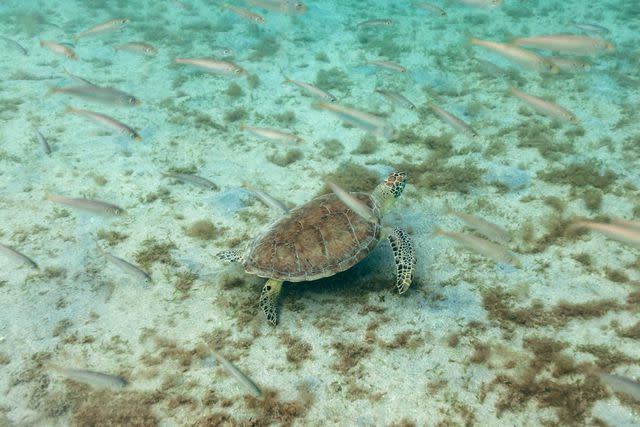Why I Love the Unspoiled Beaches of St. John, With Family-Friendly Villas, Crystalline Waters, and Wild Sea Turtles
This travel writer loved visiting St. John with her father. After her father's death, and Category 5 hurricanes in the U.S. Virgin Islands, she returned to make new family memories.

Meredith Zimmerman
Looking out over Salomon Bay, on St. John, in the U.S. Virgin Islands.One hot, windy afternoon in February 2007, my dad and I pulled on flippers and swam out of the cove at Hawksnest Beach, on the northern shore of St. John, one of the U.S. Virgin Islands. The two of us had vowed, on this trip, to snorkel the seven beaches of Caneel Bay Resort.
The only one of the resort’s beaches that faces east, Hawksnest is known for afternoon winds. We had already missed our chance to make the swim in the calm of morning—that was our first mistake. The second was misjudging the difficulty of the swim around Hawksnest Point, which would take us to a beach on the other side of the rocky point. The third was overconfidence.
Still, we’d been there before, and we figured the swim would take an hour at most. Instead, the current was worse than we’d predicted, the conditions more difficult. Outside the bay, we bobbed in 80-foot-deep water. Boats charged by, unable to see us. We started to tire, plugging along, hoping to be rescued—or to make it to the other side of the point. Half an afternoon later, we tumbled onto the sand of Turtle Bay, shaken and exhausted.

Meredith Zimmerman
From left: Snorkeling off St. John; Cruz Bay flora.We’d been foolish; later we would joke about our misfire. It turned out to be our last great adventure together, in the place we loved most in the world. Two years after our swim, a twinge in my father’s leg signaled the early stages of ALS. When he died, in 2011, my family and I brought his ashes to St. John.
In the years since my father and I tempted fate, I have returned to the island many times, visiting snorkeling spots and reefs, communing with his spirit. I had planned to go again in 2017, but that September back-to-back Category 5 hurricanes, Irma and Maria, slammed into the islands. The storms tore apart Caneel Bay Resort — and nearly destroyed all of St. John.
But this isn't a story of grief. It’s a story of revival. At seven miles long and three miles wide, St. John is the smallest of the three primary U.S. Virgin Islands. The United States purchased the territory from Denmark in 1917 for $25 million to establish a naval base that would discourage German invasion. Thirty-five years later, American financier Laurance Rockefeller visited St. John while yachting in the region. “I found the combination of mountains, beaches, and sea unique in the Caribbean,” he said in a 1954 interview with the New York Times. “The unspoiled nature of the area appealed to me, and I wish to preserve it against overdevelopment.” Between 1952 and 1956, Rockefeller purchased 5,000 acres — nearly 60 percent of the island — from various parties. He then donated the land for the establishment of Virgin Islands National Park, the country’s 29th.
Today, almost all of St. John feels unspoiled. Consider Hale Lani, the villa I rented with my husband and kids last January in Maria Bluff, a neighborhood high above Great Cruz Bay, just south of the island’s main town of Cruz Bay.

Meredith Zimmerman
From left: Bougainvillea on St. John’s East End; a view of the shoreline from a Calypso Charters boat.Pink bougainvillea, spilling down a wall, greeted us when we arrived. The house’s spacious lanai connects the pool with the main living space, whose doors frame the water like a picture window. We pushed them open just before magic hour, the ideal time to sample Hale Lani’s bar, which guests traditionally restock before leaving. While our sons catapulted into the pool, we took advantage of our predecessors’ largesse with some Cruzan rum, splashed with pineapple juice. We left the same on departure.
Much on St. John has been rebuilt since the storms. But I was curious about the conditions under the sea, so I hired the Tropicat, a 26-foot power catamaran run by Calypso Charters, to take our family to the national park.
We headed to Scott Beach first, a snorkeling favorite of my dad’s and another of the seven beaches on the grounds of Caneel Bay Resort, which remains closed. Visitors are not allowed to access the beach by land, but can still enjoy a swim if they approach by sea. I flung myself from the boat, hoping to find the thriving underwater world of sea grass and hawksbill turtles that I remembered.
But the hurricanes had changed the sea bottom, too. The grasses were gone. Then, a flash of blue on blue: a four-foot-long barracuda reminded me that, underwater, you never know what you’re going to see. Where turtles once thrived, now a magnificent predator swam alone.
Later, our captain, Jason Ward, dodged a series of afternoon squalls to reach Lameshur Bay, on the island’s southern shore. “This is one of my favorite snorkeling spots,” he said. I could see why. The water was cerulean. But the seabed has a ledge and suddenly plummets 70 feet. From the surface, you couldn’t see how majestic the scene was, but right below, it was as if the lights had suddenly been turned on, a world alive in Technicolor. Out of this display, on a sloping outcrop of rock, a tiny hawksbill headed up from the abyss, nibbling at the brilliant coral.

Meredith Zimmerman
From left: The living room of Hale Lani, a rental villa near Great Cruz Bay; a surfside Painkiller cocktail near Cruz Bay.The signature drink of Love City, as locals refer to the island of St. John, is the painkiller — dark rum, orange juice, pineapple juice, and cream of coconut. Many places claim to mix the best version, but for my money it’s the frozen one that’s served at the Longboard, a casual spot in the town of Cruz Bay that opened in 2015. Enthusiasm for the Longboard — for its pain-reducing drinks and chili-mango-glazed wings — seems to have grown among locals and visitors alike since the storms.
We found many of the other restaurants on the island buzzing, too, including Pizza Pi, a floating pizzeria that’s moored in Christmas Cove, a short boat ride from Cruz Bay, and churns out superlative wood-fired pies. In the opposite direction, in the town of Coral Bay, the swim-up restaurant the Lime Out allows patrons to sit in floating pods while digging in to blackened-tuna tacos and coco coladas, made with dark rum and fresh lime juice.
Other ventures are similarly fueling St. John’s comeback. One morning, my family boarded a shuttle to Lovango Cay, a private island a 10-minute boat ride from Cruz Bay. These days, it’s home to Lovango Resort & Beach Club, a project years in the making from Little Gem Resorts owners Mark and Gwenn Snider, who also have properties in Martha’s Vineyard and Nantucket. It has a collection of luxury tree houses and glamping tents, plus a three-bedroom villa. The resort also offers beach chairs and cabanas for day-trippers, whether they’re coming to dine or to enjoy time by the pool. To me, Lovango seemed perfectly poised to fill the chasm left behind by Caneel Bay Resort’s continued closure.
With my children distracted by a crystalline swimming pool, I hitched a ride on a golf cart to the island’s less developed side, where lush vegetation gave way to a more rugged vista: water gnashing across the rocks in one direction, a secluded pebbled beach in the other. I snorkeled alone, this time in a forgotten cove, with queen angelfish as large as my head ducking in and out between boulders.

Meredith Zimmerman
A green turtle spotted during a snorkeling excursion.On our penultimate morning, we visited Francis Bay, on the northern shore of the island. There was a tropical drizzle in the air, and wild donkeys sought refuge in the brush. Past them lay a tidal pool with an aquamarine bottom.
It was there that we saw it, right below the surface of the water: a green sea turtle, distinguished by the markings on its carapace and its size — it must’ve been the length of both my arms outstretched. On its back, the turtle carried a neon remora, or suckerfish. My husband, sons, and I trailed behind, our snorkels on, silent in the shallows. The rain had stopped, and the turtle blinked in the sunlight before heading back down.
The next morning, I swam long and hard past a well-preserved reef fringing Hawksnest Beach. Out to the right, a precipitous drop swiftly turned the seabed from sand to grass, a secret grove of turtles. I’d stumbled onto it purely by luck.
But it wasn’t just the grazing turtles that made me catch my breath. It was the realization that, despite the destruction of the hurricanes — to say nothing of COVID — the island was still holding on.
And yet some worry that St. John is changing, perhaps too much. Is the coral as vibrant as it was a decade ago? It isn’t, just as it isn’t in most places. The future of Caneel Bay Resort is uncertain, as a dispute between the property’s developer and the National Park Service, which owns the land, seems locked in a stalemate.
Those who, like me, go back to this enduring island year after year make the trip for the small and beautiful moments it delivers. Though I no longer have my father at my side, I’m still chasing these simple pleasures: a hawksbill turtle swimming up from the depths, the impossible blue of the sea.
The Best of St. John
Where to Stay
Hale Lani: This four-bedroom villa in Maria Bluff has unobstructed sea views from every room.
Lovango Resort & Beach Club: This newly opened private-island resort has glamping, tree houses, and a villa, plus a beach club, pool, restaurants, and shops.
Where to Eat and Drink
Lime Out: Stationed in Coral Bay, this floating restaurant allows guests to get their feet wet while enjoying tacos and cocktails.
Pizza Pi: Moored in Christmas Cove, this improbable wood-fired-pizza spot is accessible only by boat.
The Longboard: Known for its frozen Painkiller cocktail, this restaurant also serves standout fresh-catch ceviche and ahi tuna lettuce wraps.
What to Do
Calypso Charters: Owners Scott and Sheree York offer half- and full-day trips on their catamaran Tropicat.
Francis Bay Beach: The most protected of the North Shore beaches, Francis Bay is sandy and calm, with a reef on the eastern side.
Hawksnest Bay: Home to a well- preserved reef with hawksbill and green turtles, the bay’s public beaches — not to mention the parking, restrooms, and grills — make this spot a local favorite.
A version of this story first appeared in the February 2023 issue of Travel + Leisure under the headline "Rising on the Tide."
For more Travel & Leisure news, make sure to sign up for our newsletter!
Read the original article on Travel & Leisure.